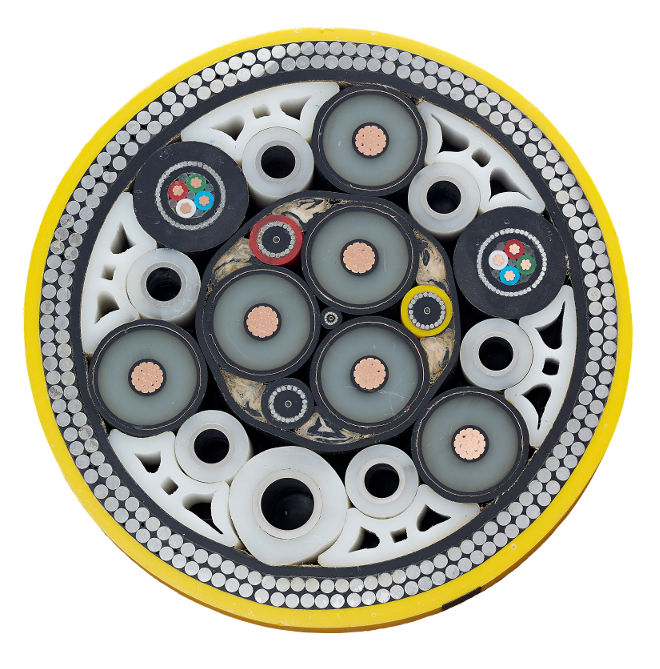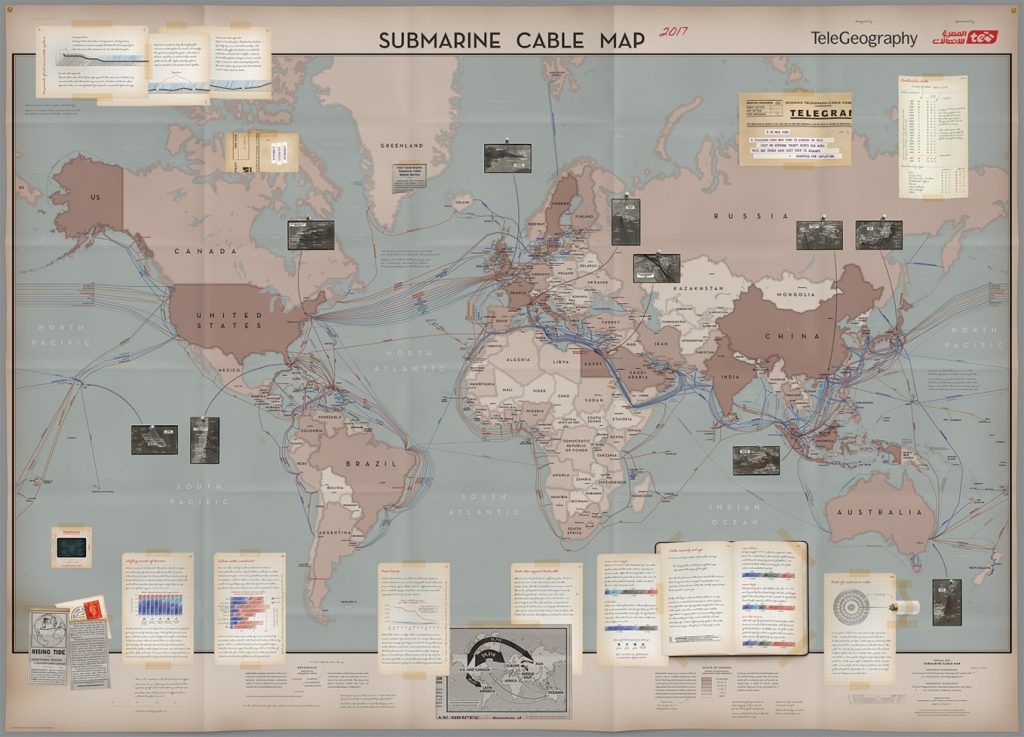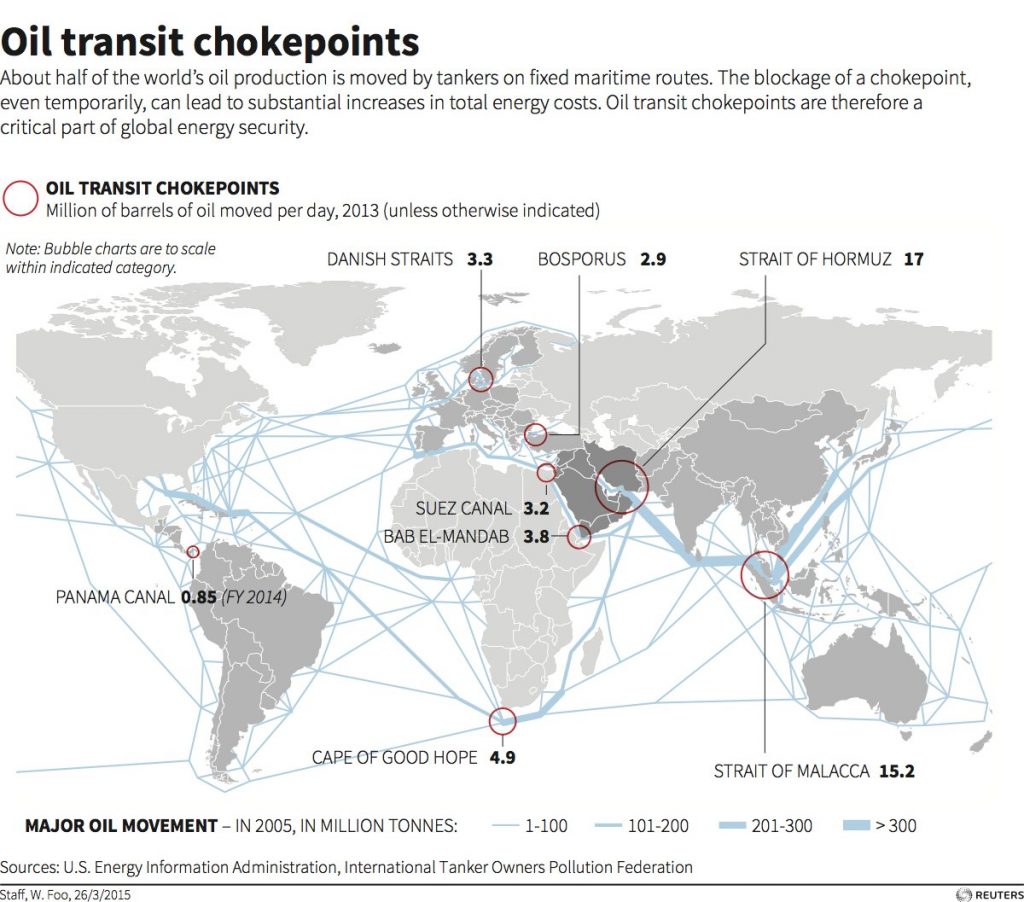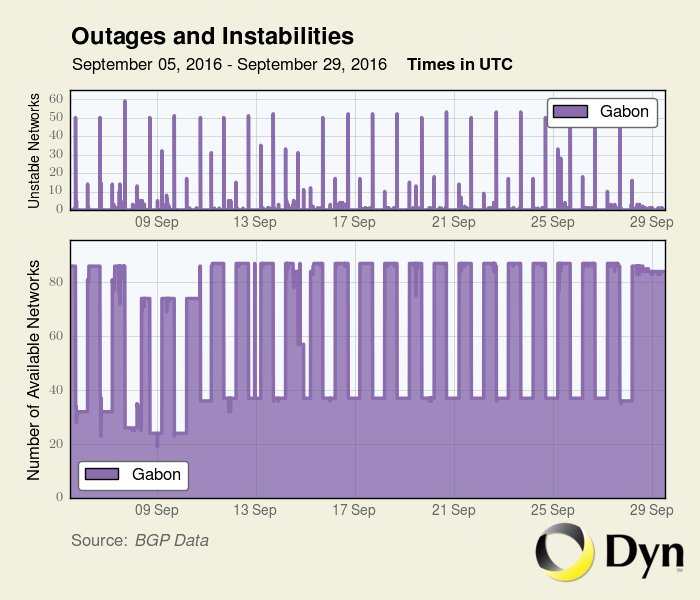A chokepoint is a narrow corridor, a structural feature that restricts flow. Chokepoints are parts of a system that threaten to become a site of congestion or blockage, where movement might be stopped with very little effort. The network is often imagined as a form that routes around or bypasses chokepoints, but all networked systems still have at least one chokepoint. In most cases, they contain many bottlenecks, pressure points, and points of failure. This is true even for apparently distributed systems like the internet.
Our undersea cable system forms the backbone of the global internet. The most frequently discussed and debated chokepoints in this system are geopolitical chokepoints. For example, if one looks at the map of the undersea cable system (see fig. 1), it’s easy to locate where cable routes funnel through narrow geographic zones. These include the Strait of Malacca (between Malaysia, Singapore, and Indonesia), the Strait of Luzon (between Taiwan and the Philippines), and the crossing of Egypt and the Red Sea. At each of these points, cable traffic is rendered vulnerable not only because of geographic constraints (e.g. a canal, submarine topography), but also political constraints (including both national, territorial, and oceanic politics) that make it difficult to route elsewhere. Forced along a narrow path, cables often are subject to an increased threat of anchors, subsea movements, and nations and companies that control the space.
The potential effects of these chokepoints on the internet are enormous. As one influential study reported in 2010, “There are several geopolitical chokepoints that funnel … critical cable paths together. A single disaster in such an area could cause catastrophic loss of regional and global connectivity” (Rauscher 2010: 24). The most significant of the cable chokepoints is in Egypt. Sunil Tagare, CEO of OpenCables Inc., points out, “Egypt is the biggest single-point failure in the world.” He estimates that if “Egypt goes down, at least one third of the global Internet will go down.” Narrow routes give the advantage, of course, to those who control the chokepoints. As Tagare elaborates, “Telecom Egypt, well aware of its monopoly, is milking the situation to its extreme advantage … The cost of IP Transit to that part of the world has increased by an order of magnitude just because of the Egypt monopoly and choke point” (personal communication, September 19, 2017). It’s perhaps not surprising that many geopolitical chokepoints are shared between networks: the Suez Canal and Strait of Malacca long have been critical maritime chokepoints, and in turn, chokepoints in the shipment of oil (see fig. 2).
While geopolitical chokepoints emerge because cables are unable to route elsewhere, perhaps due to the contours of land and water, the composition of the seafloor, or political tensions, topological chokepoints are formed because traffic tends to cluster at particular nodes. These narrow routes are formed not according to the logic of avoidance but, by and large, due to the laws of attraction. Topological chokepoints also are visible in network maps. Take, for example, the intense concentration of cables in Miami or in Fortaleza, Brazil. In these cases, there’s no clear environmental or territorial reason that all the cable lines converge at a single point or set of points—it is a matter of path dependence. Cables could stop in many places on the United States’ and the Brazilian coast, but it’s much easier to interconnect with everyone else in a single common zone. If a node has extensive infrastructure, it often doesn’t seem to be a chokepoint at all—it simply appears as a hub of the global internet.
No matter how quickly and smoothly traffic routes through network hubs, they also are vulnerable sites, especially if there hasn’t been an economic incentive to create multiple, autonomous nodes. If Fortaleza were shut down, all data traffic that flows north and south through the cable station would come to a halt—it is a single point of failure for all undersea cables from Brazil to the United States (Makris et al. 2010). Artist and scholar Ruy Cézar Campos has been tracking Fortaleza’s declaration of the neighborhood around the cable station as a Technological and Creative Park, with tax incentives to build more stations. “In contrast to this interest,” he writes, “is the fact that this neighborhood is one the most violent in this city and that it has one of the highest salt densities in the world … fostering unwelcoming precarities to high security technological buildings and installations” (personal communication, September 21, 2017). The landing points themselves—the zones where cables cross beaches and connect cable stations to the ocean—also can become congested. In Fortaleza, the heavy concentration of cables on one part of the coast means that new systems must establish new routes through offshore seamounts: even if the node is a hub, it still faces geological challenges specific to its location (Wopschall et. al. 2013). A single location might, at different scales, be a site of both asymmetrical geopolitical and topological relationships.
Although cable stations and network nodes are some of the more obvious chokepoints, there are also places where a single cable is a chokepoint. In many countries, where only a few (or even one) cable connects to the rest of the world, all international traffic is funneled through a single link—chokepoints can emerge both in conditions of excess and in conditions of scarcity. Plus, not all chokepoints are visible on the network map. Chokepoints might be caused by a concentration of routes, not in space but in ownership. In some countries, a single telecommunications carrier controls all potential pathways between points. A single company might even control all traffic into and out of the country. Dyn Research has been tracking critical outages and national blackouts for years: in Syria, Iraq, Ethiopia, Gabon, Cameroon, and others. They have shown that having only one or two providers puts countries at severe risk for a national outage (Cowie 2012). When there are chokepoints in ownership, flow is easily restricted or blocked, regardless of how many geographic routes or network hubs exist.
Another form of invisible chokepoint is the regulatory chokepoint, where national or international laws and regulations slow and even block internet traffic. A key example of a regulatory chokepoint exists in Indonesia, which in 2011 required that only Indonesian ships with an Indonesian crew would be allowed to repair cables that broke in the country’s territorial waters. However, there were no such ships at that time—existing cable ships, in order to be exempt temporarily from these requirements, would have to complete an extensive permitting process. That created a significant delay in repair time for internet cables and, combined with a high fault rate, as Keith Ford-Ramsden and Douglas R. Burnett observe, this “has made Indonesia a choke point in international communications” (2014: 171). The effects of such regulatory chokepoints are not limited to prolonging Indonesian internet outages but to the many countries in Southeast Asia, Australia, and beyond that depend on cables that route through Indonesian waters. Sunil Tagare points out that extreme regulations in India are causing similar problems: these include laws about cable ships in Indian waters and requirements to install monitoring equipment for bandwidth terminating in India—the high cost of this, he argues, “makes it prohibitively expensive and laden with regulatory gray areas for carriers to conduct business.”
The regulations in India and Indonesia point to another potential site of failure—the inability to secure labor to sustain a system. Every network depends on a set of workers. And workers that are integral to network operations can constitute a chokepoint in labor. Although the history of dock workers and union labor might be a more familiar example of how bodies can thwart a system’s operation, the internet and its cables are heavily dependent on a small set of specialized workers. There’s not a strong tradition of union organizing in the cable world, but there are shortages of experienced and capable cable workers in many places, often in companies and countries new to the cable industry.
Systems depend on other systems. As a result, chokepoints cascade. Undersea cables, and their varied chokepoints, constitute the weak link of other networks: air transportation, shipping, and global financial networks. Take as an example the recent APEC Supply Chain Connectivity Framework Action Plan, which identified “underdeveloped” multimodal connectivity, including the frequently disrupted cable systems in the Asia Pacific region, as a key chokepoint in the area’s supply chains. What might seem to be a minor chokepoint in one system can become a more significant chokepoint in a system that depends on it. We might describe this as a chokepoint of dependency: the bottleneck created when a network relies on a single system to fulfill a particular function.
One of the distinct features of contemporary global systems is that almost all of them rely on the undersea cable network for international communications. The cable system is a chokepoint of dependency for global finance, transportation, supply chains, and the multitude of other networks of international exchange. However small they might seem—bound to particular cities, bodies, or seas—the failures of the cable network easily can cascade to compromise all who depend on it. These chokepoints are not only the sites where the internet can be strangled, they are the places where the internet—long seen as that which enables and connects—can unravel many other forms of global circulation.



